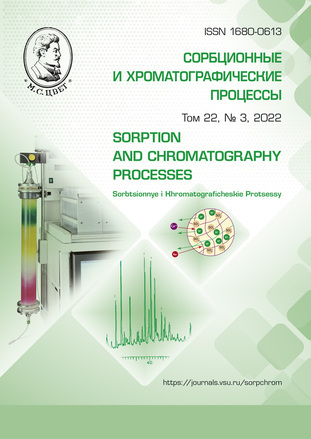Study of dopamine sorption on γ-Al2O3 and Strata-SDBL sorbents
Abstract
Catecholamines, especially dopamine, play an important role in regulating many vital processes in the human body (psychomotor function, cardiovascular function, and mental state). Monitoring their levels in the body allows early detection of certain diseases. The analysis of catecholamines is complicated by their low content in bodily fluids (the dopamine norm for adults is less than 0.13 nM in blood and from 0.3 to 3 µM in daily urine). To determine catecholamines, it is necessary to preconcentrate them. The aim of this work was to study the adsorption of a representative of catecholamine class, dopamine, on sorbents of different nature, to determine the physical and chemical characteristics of its adsorption, and to choose the optimal sorbent for the sorption concentration of catecholamines.
We compared the features of dopamine extraction from aqueous solutions by γ-Al2O3 and Strata-SDBL sorbents under static conditions and studied the effect of various parameters (pH, phase contact time, dopamine concentration) on the sorption. The distribution of dopamine in the water-sorbent system was monitored using RP-HPLC with an amperometric detector. Maximum extraction of dopamine was achieved at pH 8-9 on γ-Al2O3 and at pH 5-11 on Strata-SDBL with sorption time of 20 minutes. Isotherms of dopamine adsorption on the above sorbents were obtained. It was shown that they belonged to the class of Langmuir isotherms. It was determined that γ-Al2O3 had a significantly higher sorption capacity with respect to dopamine and a higher adsorption constant than Strata-SDBL. It was suggested that sorption of dopamine on γ-Al2O3 occurred mainly due to electrostatic interactions and hydrogen bonds, while for Strata-SDBL, it was due to hydrophobic and π-π-interactions.
For the sorption concentration of catecholamines at low concentrations in the sample, it is advisable to use γ-Al2O3. However, Strata-SDBL can be recommended for the express concentration of catecholamines under dynamic conditions.
Downloads
References
Southwick S.M., Paige S., Morgan C.A., Bremner J.D., Krystal J.H., Charney D.S. Neurotransmitter alterations in PTSD: catecholamines and serotonin. Semin. Clin. Neuropsychiatry. 1999; 4: 242-248. https://doi.org/10.153/SCNP00400242
Karim M.M., Alam S.M., Lee S.H. Spectrofluorometric estimation of norepi-nephrine using ethylendiamine condensa-tion method. J. Fluoresc. 2007; 17: 427-436. https://doi.org/10.1007/s10895-007-0188-y
Secor K.E., Glass T.E. Selective amine recognition: development of a chemosensor for dopamine and norepineph-rine. Org. Lett. 2004; 6(21): 3728-3730. https://doi.org/10.1021/ol048625f
Whiting M.J., Doogue M.P. Advanc-es in biochemical screening for pheochro-mocytoma using biogenic amines. Clin. Bio-chem. Rev. 2009; 30: 3-17.
Kagedal B., Goldstein D.S. Catecholamines and their metabolites. J. Chroma-togr. B., 1988; 429: 177-233. https://doi.org/10.1016/s0378-4347(00)83871-2
Sidorova A.A., Kartsova L.A. The chromatographic and electrophoretic deter-mination of catecholamines, metanephrines and 3,4-dihydroxyphenylalanine in urine and blood plasma. Sorptsionnye I khromatograficheskiye protsessy. 2009; 9(6): 774-782.
Dirks B., Vorwalter C., Grünert A., Ahnefeld F. W. Basal plasma-catecholamine-level determination using HPLC-ED and different sample cleanup techniques. Chromatogfaphia. 1988; 25(3): 223-229.
Paulose C. S., Dakshinamurti K. Chronic catheterization using vascular-access-port in rats: blood sampling with minimal stress for plasma catecholamine determination. J. Neuroscience Methods. 1987; 22: 141-146. https://doi.org/10.1016/0165-0270(87)90008-2
Salzman S.K., Sellers M.S., Beckman A.L., Ramarao N., Macewen G.D. Deter-mination of intraoperative plasma catechol-amine concentrations using liquid chroma-tography with electrochemical detection. J. Chromatogr. B. 1985; 343: 285-301. https://doi.org/10.1016/S0378-4347(00)84598-3
Floysand R., Serck-Hanssen G. De-termination of tissue content of catecholamines in Atlantic Salmon (Salmo Salar): a comparison of HPLC-EC and the tryhydroxyindol fluoremetric method. Camp. Biohem. Physiol. 1991; 99(3): 451-462. https://doi.org/10.1016/0742-8413(91)90271-t
Jouve J., Bakri D., Herault J., Muh J. P. Determination of urinary vanillactic acid and plasma dihydroxyphenylalanine as markers of non-secreting neuroblastoma by high-performance liquid chromatography with electrochemical detection. J. Chromatogr. B. 1991; 567: 331-341. https://doi.org/10.1016/0378-4347(91)80139-4
Koch D.D., Polzin G.L. Effect of sample preparation and liquid chromatography column choice on selectivity and pre-cision of plasma cateholamine determina-tion. J. Chromatogr. 1987; 386: 19-24. https://doi.org/10.1016/s0021-9673(01)94580-7
Wu D., Xie H., Lu H., Li W., Zhang Q. Sensitive determination of norepineph-rine, epinephrine, dopamine and 5-hydroxytryptamine by coupling HPLC with [Ag(HIO6)2]5-–luminol chemiluminescence detection. Biomed. Chromatogr. 2016; 30: 1458-1466. https://doi.org/10.1002/bmc.3704
Woo H.I., Yang J.S., Oh H. J., Cho Y.Y., Kim J.H., Park H.-D., Lee S.-Y. A simple and rapid analytical method based on solid-phase extraction and liquid chromatography–tandem mass spectrometry for the simultaneous determination of free cat-echolamines and metanephrines in urine and its application to routine clinical analysis. Clin. Biochem. 2016; 49: 573-579. https://doi.org/10.1016/j.clinbiochem.2016.01.010
Thomas A., Geyer H., Mester H. J., Schänzer W., Zimmermann E., Thevis M. Quantitative determination of adrenaline and noradrenaline in urine using liquid chromatography-tandem mass spectrometry. Chromatogr. 2006; 64: 587-591, https://doi.org/10.1365/s10337-006-0067-8
Peterson Z.D., Collins D.C., Christo-pher R., Bowerbank C.R., Lee M.L., Graves S.W. Determination of catechola-mines and metanephrines in urine by capil-lary electrophoresis–electrospray ionization-time-of-flight mass spectrometry. J. Chromatogr. 2002; 776: 221-229. https://doi.org/10.1016/s1570-0232(02)00368-9
Xiaoguang L., Shu L., Wynveen P., Mork K., Kellermann G. Development and validation of a specific and sensitive LC-MS/MS method for quantification of urinary catecholamines and application in bio-logical variation studies. Anal Bioanal Chem. 2014; 406: 7287-7297. https://doi.org/10.1007/s00216-014-8120-1
Xiaoguang L., Shu L., Kellermann G. Pre-analytical and analytical validations and clinical applications of a miniaturized, sim-ple and costeffective solid phase extraction combined with LC-MS/MS for the simultaneous determination of catecholamines and metanephrines in spot urine samples. Talan-ta. 2016; 159: 238-247, https://doi.org/10.1016/j.talanta.2016.06.032
Raggia M. A., Puccia V., Sabbionia C., Furlanettob S., Gerra G. Simultaneous determination of plasma catecholamine me-tabolites (homovanillic acid, 3,4-dihydroxy phenyl acetic acid, 3-methoxy-4-hydroxyphenylglycol) using liquid chroma-tography with amperometric detection. J. Sep. Sci. 2001; 24: 275-281. https://doi.org/10.1002/1615-9314(20010401)24:43.0.CO;2-5
Mercolini L., Gerrab G., Consortia M., Somainic L., Raggi M.A. Fast analysis of catecholamine metabolites MHPG and VMA in human plasma by HPLC with fluo-rescence detection and a novel SPE proce-dure. Talanta. 2009; 78: 150-155. https://doi.org/10.1016/j.talanta.2008.10.049
Tolmacheva V.V., Yarykin D.I., Serdiuk O.N., Apyari V.V., Dmitrienko S.G., Zolotov Yu.A. Adsorption of catechola-mines from their aqueous solutions on hy-percrosslinked polystyrene. React. Funct. Polym. 2018; 131: 56-63. https://doi.org/10.1016/j.reactfunctpolym.2018.07.005
Tolmacheva V.V., Yarykin D.I., Gorbunova M.V., Apyari V.V., Dmitrienko S.G., Zolotov Yu.A. Preconcentration of catecholamins on hypercrosslinked polysty-rene and their determination by high-performance liquid chromatography. J. Anal. Chem. 2019; 74(11): 1057-1063. https://doi.org/10.1134/S1061934819090107







